Custom Shop: Birdsong Guitars
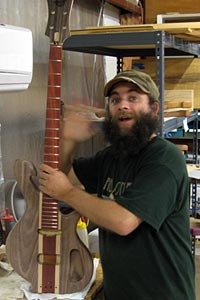 Founded in 2004, Birdsong Guitars is a company with a distinct reputation for excellent short-scale basses – one that founder Scott Beckwith prides himself on.
Founded in 2004, Birdsong Guitars is a company with a distinct reputation for excellent short-scale basses – one that founder Scott Beckwith prides himself on.
After getting his start building in the late ’90s, Beckwith set up shop in Texas where he has been honing his craft with the aid of his wife and other luthiers. Most recently he revived the S.D. Curlee Brand of the ’70s with the blessing of the original company members.
A man with an appreciation for simplicity done well, Beckwith has a knack for improving without overdoing. In this exclusive interview, he shares his story and solid advice for those interested in luthiery, as well as the scoop on Birdsong and S.D. Curlee.
How did you get into building basses?
For me it was the next step on a path of music I’ve followed since about 12. From awakening to music to becoming a guitar player, to bassist, to professional to teacher, retail shop owner, repairman. I had my own ideas on features and form, and it got to where I bought something new and didn’t even play it before I took it apart. At that point it was “Well maybe I should just make something.” After doing that and repairs on a bunch of already-made guitars and basses, I started seeing patterns, and the ingredients of tonal properties and ergonomics – as well as a lot of ways not to do things – became apparent. The first bass I built was a short scale, there was a need there I could relate to (and a waiting client) so that’s where I started in 1997.
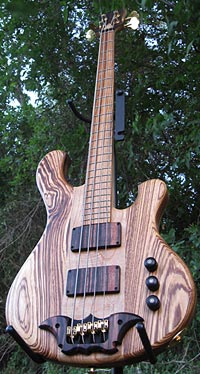
What is the concept behind your designs?
Biggest sound out of the littlest basses possible. More of a group of ideals – how a bass should balance, how big is necessary, what types of voices it should have. What does building tools of creation mean to me? These impacted them to become what they are. Values like simplicity, durability, and human handwork by hands called to do this and not necessarily (all respects to them) factory line workers… those also affected the basic designs just as much. It was all mulch and fertilizer in the garden that grew them.
On your site, you explain that you “designed out all the shortcomings of old designs” of short scale basses. What do you see as the problems with other short scales?
The oldie short scales are cool and iconic but generally the balance sucks and the sound – other than for what they’re famous for, like McCartney and the violin bass, or “that Dano sound”, for example – wasn’t all that great or versatile. The new short scales mostly seemed to be either remakes of the old but without actually improving any of the negatives about them, or cheap price-point imports aimed at students that aren’t suitable for professionals or anyone who wants something more than, well, a cheap price-point import! I couldn’t find a durable, pro quality short scale that sounded like a bigger bass and balanced. And that fit me – sticking a short neck way out on a big body only proves it wasn’t designed by someone short, the folks that could really use it! I’m 5’4” and I designed the Cortobass for me… everything I wanted in, everything I didn’t out. Players of all sizes play them, and I love that, but they are light and balanced enough for small-statured players with narrow shoulders and short arms.
How does your own playing affect the way you make basses?
I’m a decent, solid but basic player with an appreciation of various tones. I like sound. And I was a player-for-hire for years in a bunch of different styles. So I figured if I made something I thought sounded “good”, it was probably going to be a useable piece for others. Plus I’m short, and while I’d never use that as an excuse for anything, it does mean that I might appreciate having shoes that fit a little more than the 5’10” male it seems everything is designed and made for. So I make them small, lightweight, and balanced – fixed the things that were never comfortable for me on a Fender-type bass. I guess I just started building what I’d always wished I’d had when I was playing four sets a night.
You’ve just brought the SD Curlee brand back to life. What made you decide to do that, and what kind of steps did it take?

I’ve always been a fan. Builders have influences too… going back to even before we knew we’d be builders. I always thought they were cool looking in the old Guitar Player ads. If you look at a Birdsong, that natural look, the stringers, the 24 fret board with no face dots, the woods, the 2+2 headstock, there’s a definite ’70s influence from the SD Curlees and that era of BC Rich. I love that stuff. So when I couldn’t keep the puppy collar on Birdsong anymore, I figured I’d have some fun as we grew and also show some respect to a classic. There was reverse engineering, consultation with key old-school Curlee personnel, some paperwork involved, making of prototypes incorporating a slew of tweaks but still holding to the original Randy Dritz design, and the test session where the upgraded, updated prototype proved itself as a big block bottom end force of nature and lunched the speaker in the test rig. Of course I did have it dimed at the time and was blasting out some Motorhead with a pick. The voice coil was literally screaming. It was pure glory. Anyhow, figuring the horsepower was sufficient, we launched the site.
What would you tell someone who says the new basses are too expensive compared to their “poor man’s Alembic” predecessors?
Well I would say it’s a difficult discussion to have if they don’t grasp the difference between a “reissue” made in a Chinese factory and a carrying-on-of-the-marque made by hand in a small American workshop… or how something relatively simple can still end up expensive due to what was put into it. The box-store-ization of the consumer has successfully made price and discount the definition of value.
It’s also very difficult to compare what I do as a professional with other luthiers working for me in business with a workshop to what a skilled guy may be able to pull off in his basement after work. The economies (if not the results in every case, though in most) are quite different. As an American craftsman, for what I put in this is what it takes to buy one of what I do. Not everything is supposed to be made by third-world sweatshops to be sold in WalMart; some of us aim a little higher than that. Not to exclude anyone, just to aim higher than that. It means something; American craftsmanship is not dead. That does, though, mean not everyone will understand why we do it or be able to afford it. But much like the brand-new ’77 Trans Am with modern upgrades I wish I could afford but can’t, that doesn’t make it “overpriced.” It makes me underfunded.
Good quality will always cost good money because of the very level of parts, materials, and professional workmanship that makes it happen. If they’re simply concerned that they used to be six hundred bucks and now they’re a lot more, they have to realize they were six hundred bucks thirty years ago, when gas was 50 cents a gallon and a new truck was $3,500. Now that truck costs what a 3 bedroom house did then. So comparing prices like that, or to a beat up original, is a little nutty. My ’74 pickup didn’t cost what a new one does either.
As for the initial comparison, which isn’t exactly apples and apples either. Have you priced a new Alembic recently? Our entire hand-made American bass prices out equal to a top upgrade and a set of gold hardware! But don’t kvetch, they make Rolls Royces; you can either afford one or you can’t. Their clients don’t complain about the value and neither do ours.
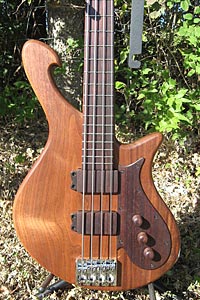
Tell us about your process in creating an instrument for someone.
They generally come to me through the site or an ad that gives a definite flavor of what we do, so we start on common ground. We figure their needs and their wants (two different things) and match up a model of ours, the wood considerations tonally and cosmetically, and the details like hardware, artistry, and any special considerations.
For example, if a client has a physical issue, I can compensate something in the build to help it be a better tool for them. Or they might like a mentor’s name or spiritual symbol woodburned on the back of the headstock. That stuff is all an honor to do, to be of such service that has such meaning. There’s a client builds page on the site where they watch it come together, and then it gets shipped. I’ve been blessed with a pretty good set of instincts as to knocking it out of the park for someone. I live and breathe, eat and sleep music and have for 30 years; that’s a lot of tonal references. I like to go deep and ask questions. Then I build the answers into their bass.
What is your opinion of bolt-on versus neck-thru construction?
To me, done to a high level and close tolerances they’re just two paths to the same place. Some folks seem to need to debate and berate and I’m glad it gives them something to do… but I like instruments; I like all the different ways they go together.
Tonally I like different wood in the neck and the body, so it’s bolt-on or in or set-neck for me. A good tight neck pocket gives away nothing in sustain anywhere you’ll find it when actually playing music. And the whole thing about neck-through being THE “premium” way to build… and I’m talking luthiery here, rasps and routing and sawdust, not just screwing catalog copy parts together and slappin’ on a logo (they call that “badge engineering” in cars)… in this context, not having to cut a good neck pocket or deal with wood wider than six inches makes neck-through a whole lot easier to begin with. But I like it all, I’m an enthusiast of stringed instruments and a fan of luthiery of all types. “Oh, I must have a neck through!” That’s like saying you’ll only date blondes… that redhead might’ve rocked your world.
What is your opinion of active versus passive pickups?
I think the amplifier is the best active tone shaping circuit; that’s what it’s designed to do, with all the power in the world. [For] the instruments, I prefer passive, with the sound of the wood in the midrange coming through uncolored to sit in the mix like so much sweet maple syrup. I mean I drive a ’69 Dodge and rarely use a cell phone. I don’t want a NASA command center down there. Give me a volume and a nicely voiced passive tone control and I’m happy. So that’s what I build, what I like, what I understand, what speaks to me.
So often the one thing my ear wants is what is sacrificed in an active circuit for all that artificial enhancement that sounds like the voice of God in your living room but is a bunch of rumble and clank onstage. I like the acoustic element to be there even in an electric and part of the fun for me is preserving that as the wood makes its transformation. Come to think of it, the visual equivalent of this is why I only hand rub oil finishes and don’t do the thick shiny glossies – it’s the same thing. Sorry, my inner granola is showing!
What is your favorite part about building basses?
Getting to talk to the client, getting to figure out what they’re about and where they’re at so I can build that into their instrument. During the build it’s when the body gets rounded over during routing and shaping. To me, that’s when it stops being a body blank and becomes a bass or guitar. It starts showing its curves; the lines start to soften, it becomes sculpture. I have to mention rubbing in the oil blend by hand; that’s when my woodworking mentor “Uncle Johnny” Kirtland told me the wood comes back to life again. You can see it happen. You can feel it. So that part has taken on a ceremonial aspect for me.
Those are my favorites of the actual process. Probably the biggest favorite part though is knowing I have brought my highest to work I’ve been led to and have offered so much of it into so many others’ lives and music, and I think of all the good vibrations and good times and shared experiences all that music spreads out in so many directions into the world… it is an honor to be a part of those ripples. That is my ABSOLUTE favorite part.
How many basses have you built to date?
Somewhere around 400 would be my guess.
How do the more recent ones compare with the first?
More refined in detail, but tonally very similar. I built my whole line from the tone up to begin with. I had voices I knew would be nice, and certain ergonomic things I was going for, and all of that put a few dots in place; then the way they got connected visually, and none of that has really changed. Maybe a swoop here and a scroll there as different model variations evolve into creation, but mainly I’d say detail and confidence. And of course it’s not just me and my wife anymore [on the team]. Jamie went back to school and got her Master’s Degree in Sociology once we were firmly in flight, and I have a bigger shop now with other luthiers helping it happen at this level. Everybody does what they do best, by choice, and that’s when magic happens!
What’s the craziest thing you’ve been asked to incorporate in one of your basses?
Other than the obviously “missed what we’re about/active trem/LED/airbrushed mermaid with flame throwing nipples” crowd I politely steer elsewhere, a mid-conversation request for a finish that could withstand fake blood. You know, as if that was the only thing keeping what I do from being appropriate musically OR visually in any situation where fake blood and viscera would be flying around the stage. And he was one of the guys angling for a free bass “for exposure” too… think of the market segment I missed out on there! I know, I was so close, man. But hey, from what I hear that sort of thing takes real guts. (Sorry.)
What would you tell someone thinking of building his or her own bass?
Come up with an idea, make it into bite sized plans, then look at it as a whole. The best thing you can do to a song you’re writing is to rewrite it a couple of times; same thing here. Then learn what you don’t know by doing it, by starting at step one… when you don’t know what to do next, learn that. Yourself – go to a luthier you respect, buy Hiscock’s book, read up & watch videos on the ‘net. Don’t say a word on a public internet forum about anything you’re planning on doing, unless you like confrontation with know-it-alls and opinionated dickheads… if you’re really making anything happen in life you don’t have much time for that anyway. There are books and articles by pros on all this stuff. Get your design together, and do something original; mash your favorite aspects together. Or take a classic and really improve it. In practical terms, get some tools and practice using them. Cultivate a respect for them as you gain control over them. Take some instruments apart and you’ll see how they go together. Get competent at repairs if you plan on entering the field – it’ll pay off as each build poses its new questions and problems to you.
Open your head, open your mind, see the big picture. Gather your information, as much of it first “hand” (pun intended) as possible through playing everything you can get your hands on. Know when something’s out of adjustment that it doesn’t just “suck.” It’s a journey; play more than one of anything. Learn how to tweak out and get the best out of instruments. That’s real knowledge, not just opinionated “facts.” Make note of things you like about everything you touch; also things you don’t like. Enough of this will give you a set of specs and parts that – put together – make a different bass. Then build it. Don’t entrust the validity of anything you do to random voices in the wilderness… you know when it sounds good, you know when it plays good. And if it looks good to you, play the heck out of it. Let the talkers talk – you go make something happen. Realize any large task in life is a series of smaller steps. Prepare and take the next one, noting what is learned in the process.
Email some builders you respect for a little help. Don’t ask for their connections or proprietary info, just be cool. I get letters like this every week; I’m honored. And above all else don’t ever EVER let anyone piss away your rainbow. They’ve always been there to tell me what I’m doing can’t be done, isn’t worth doing, is impossible by their science (while I’m in a workshop making it happen for the 200th time), should instead be this way or that way; and years down the road they’re still there, same boards, same debates, same elitist self-appointed expert opinions on everything, same lives… and I have three guitar companies, instruments being played and enjoyed and spreading good vibrations all over the world, and I get to build cool basses with my friends all day.
So whether it’s one, or a company, or a song or a shop or a career – build it. If you fail, fail giving it your all. Turn off the cell phone, throw the video game out the window, step away from the screen and go carve a piece of wood. Put on some Segovia or bluegrass or Stones or whatever makes the mood, and start. The journey will make YOU as you make something out of it. Do it.

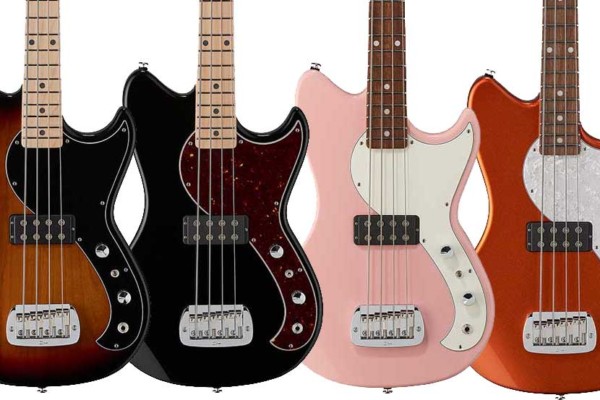
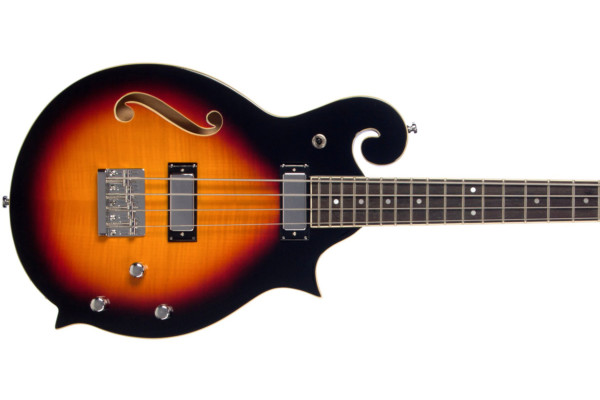
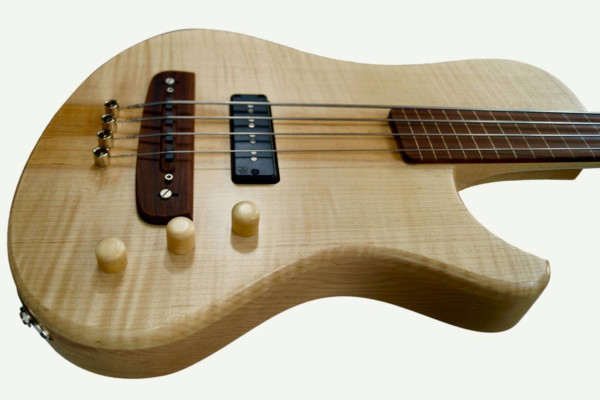
Super cool interview. Really great advice for small time guys. Thanks for this column.
Our pleasure, John. Thanks for reading!
Hi, Kevin My name is Lonnie Motley play with George Clinton and the P FUNK ALL STARS, KID ROCK, CHAKA KAHN, DAZZ, BAND to name a few and back in the late 70’s I picked up three Curlee’s two Bass’se & one guitar mine has a Strat style body and they are U.S.A model’s one with one Dimarzio P type the other is 2of the same. I have never seen any other model’s like not even a picture can I find , WellI need the original wiring for the one with the 2 Spit p type or have it restored I’ve allways love there sound want to bring it back out on the road also If you going to be at NAMM SHOW 2012 this year can we hook up some how I’dlike to check out the new ones you doing now I’m on Facebook… Lonnie “Tha 1” Motley.